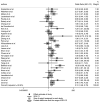Adverse clinical outcomes associated with carbapenem-resistant Acinetobacter (CRA) infections: a systematic review and meta-analysis
- PMID: 34755112
- PMCID: PMC8568848
- DOI: 10.1093/jacamr/dlab157
Adverse clinical outcomes associated with carbapenem-resistant Acinetobacter (CRA) infections: a systematic review and meta-analysis
Abstract
Background: Carbapenem-resistant Acinetobacter (CRA) infections have been associated with increased morbidity and mortality in hospitalized patients. This systematic review and meta-analysis aimed to quantify the association between CRA infections and adverse clinical outcomes.
Methods: Three databases (i.e. PubMed, EMBASE and Scopus) were searched for epidemiological studies that compared mortality, severe sepsis or shock, or bacteraemia among adult inpatients with CRA infections and those with carbapenem-susceptible Acinetobacter (CSA) infections. The pooled ORs for the three outcomes were estimated using the inverse variance heterogeneity model.
Results: Thirty-four studies were included. Patients with CRA infections had higher odds of mortality (31 studies, OR = 2.10, 95% CI: 1.58-2.79, I 2=60.6%) and severe sepsis or septic shock (7 studies, OR = 1.51, 95% CI: 1.09-2.09, I 2=0%) compared with CSA-infected patients. There was no difference in the odds of bacteraemia (four studies, OR = 1.39, 95% CI: 0.79-2.46, I 2=38.1%). CRA-infected patients presented with worse comorbidity at admission (e.g. APACHE score) (eight studies, standardized mean difference = 0.25, 95% CI: -0.01 to 0.52) and had lower frequency of appropriate antibiotic therapy. Results were consistent when pooling 16 study-adjusted risk estimates for mortality. There was no difference in risk of mortality from CRA infection when compared across geographical regions, country income, median year of enrolment and day of mortality from infection onset.
Conclusions: CRA-infected patients had worse clinical outcomes. This might be due to delay in appropriate antibiotic therapy, patients being sicker at admission and CRA strains potentially being more virulent than CSA strains. Improving appropriateness of antibiotic therapy in CRA-infected patients could reduce adverse clinical outcomes.
© The Author(s) 2021. Published by Oxford University Press on behalf of the British Society for Antimicrobial Chemotherapy.
Figures




References
Publication types
LinkOut - more resources
Full Text Sources
